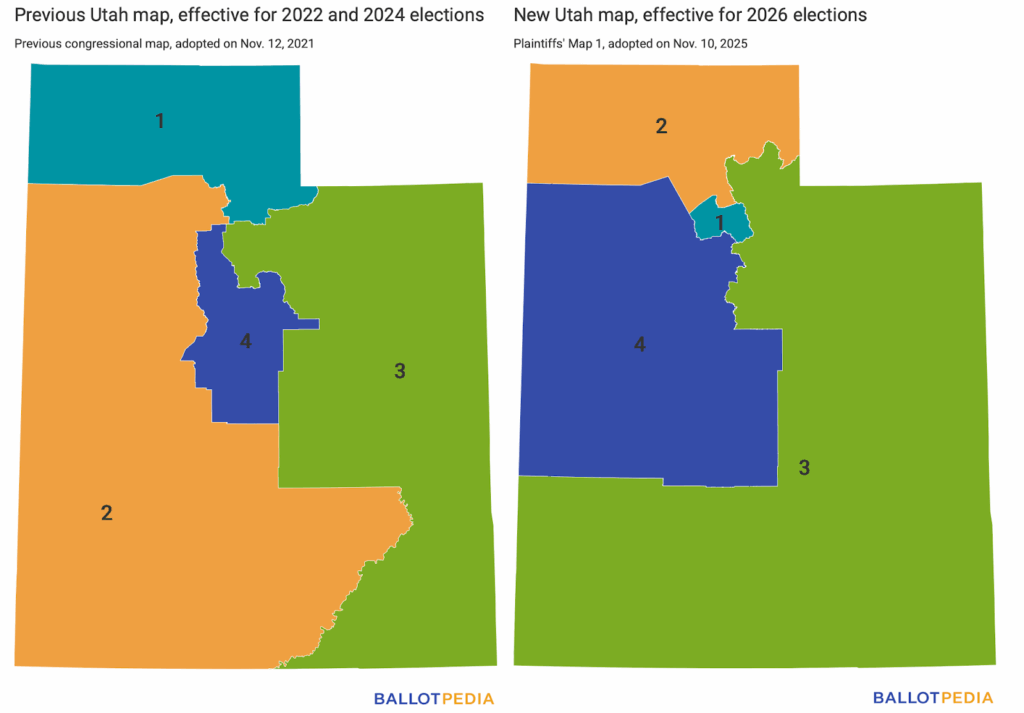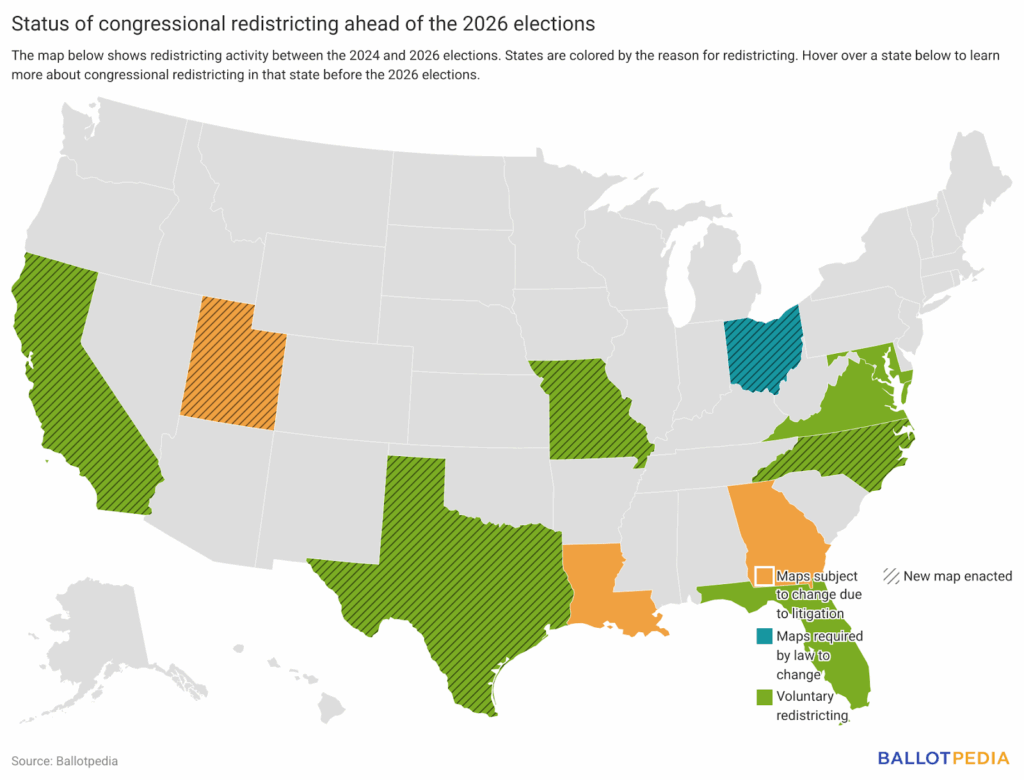Welcome to the Tuesday, Nov. 18, Brew.
By: Briana Ryan
Here’s what’s in store for you as you start your day:
- Utah becomes the sixth state with a new congressional map ahead of the 2026 elections
- In California, Shasta County voters to decide on voter ID and hand-counting ballots, and in Huntington Beach, appeals court invalidates voter ID measure
- On the Ballot breaks down the key takeaways from the Nov. 4 elections
Utah becomes the sixth state with a new congressional map ahead of the 2026 elections
Utah became the sixth state to adopt a new congressional map ahead of the 2026 midterms. On Nov. 10, a district court judge rejected a redrawn map that the Utah Legislature submitted. It would have maintained four Republican-leaning districts.
Instead, the judge adopted a proposal from the plaintiffs in the case that shifts one of the state’s four congressional districts towards Democrats. Currently, all four members of the Utah U.S. House delegation are Republicans. According to court filings, the new Democratic-leaning Salt Lake City district is approximately 43% Republican.
Taken together with redistricting in California, Missouri, North Carolina, Ohio, and Texas, Utah’s map could result in a net gain of three districts nationwide.
Previously, California voters approved Proposition 50, allowing a new map that makes five districts more favorable to Democrats according to the 2024 presidential results to take effect in the state. The new Texas map shifts five Democratic districts toward Republicans according to the 2024 presidential results. New maps in Missouri and North Carolina each aim to add one more Republican district. Ohio’s new map makes two Democratic-held districts more Republican, according to recent election results shared by the redistricting commission.

On March 16, 2022, the Utah League of Women Voters and Mormon Women for Ethical Government sued the Legislature, arguing it violated the state constitution when it repealed and replaced the citizen-approved Proposition 4. That 2018 ballot measure established a redistricting commission to draw congressional, state legislative, and school board district boundaries for the Legislature to consider.
The Utah Supreme Court ruled on July 11, 2024, that the Legislature's override of Proposition 4 likely violated voters' constitutional right to participate in government. The Court returned the case to Third District Court Judge Dianna Gibson to determine whether the Legislature's changes to the ballot initiative were "narrowly tailored to advance a compelling government interest."
On Aug. 25, Gibson struck down the state's congressional map, and ordered that the map be redrawn. The Legislature submitted a map and the plaintiffs submitted two maps to Gibson for consideration. On Nov. 10, Gibson chose the plaintiffs’ Map 1 to be used in the 2026 elections.
Three other states—Florida, Maryland, and Virginia—are still considering redistricting before the midterm elections.

Click here to read more about redistricting ahead of the 2026 midterm elections.
In California, Shasta County voters to decide on voter ID and hand-counting ballots, and in Huntington Beach, appeals court invalidates voter ID measure
In California, two recent actions have involved local ballot measures proposing voter ID requirements. In Shasta County, a citizen-initiated charter amendment on voter ID and other election administration policies qualified for the June 2, 2026, ballot. In Huntington Beach, the California Fourth District Court of Appeal ruled that a voter-approved charter amendment requiring voter ID violated state law.
Legal debates surrounding both of these measures are based on Senate Bill 1174, which prohibits local governments from passing laws to require people to present identification to vote. Governor Gavin Newsom (D) signed the bill on Sept. 29, 2024. The state Senate approved the bill 30-8, and the state Assembly approved it 57-16.
Shasta County, California
Voters in Shasta County, California, will decide on a citizen-initiated charter amendment that would add several election and voting policies to the County Charter. The proposed amendment is the first in Shasta County, which became the state's 15th charter county on Sept. 12. On Nov. 6, the Shasta County Board of Supervisors approved a resolution to put the initiative on the June 2, 2026, ballot.
The amendment proposes several changes to local election administration including:
- Requiring that elections be held in-person on a single day, except for absentee voters.
- Requiring voters to present a photo ID when voting in person.
- Limit who can cast an absentee ballot to "the infirm, military, and US citizens living overseas.”
- Requiring that all ballots be hand-counted at the precinct level.
- Requiring the county maintain voter rolls on a computer not connected to the state or any third party, among other changes.
In March, County Counsel Joseph Larmour filed a complaint in Shasta County Superior Court, arguing that the ballot initiative was unconstitutional. Supervisor Chris Kelstrom said the litigation was filed because "[o]ur county counsel has a bound duty to write a summary of this and to get it onto a ballot. He cannot ethically write that summary because it would be misleading the public in thinking that somehow we can put something on our charter and ignore state and federal laws. So the lawsuit is basically seeking relief to not have to write that summary."
Superior Court Judge Benjamin Hanna rejected the county's request for an expedited decision, stating, "This is too important of an issue for the court to make a decision on an expedited basis." Laura Hobbs, who co-sponsored the ballot initiative, said, "We felt that we were being targeted politically, and that was an intimidation tactic, and fortunately it did not succeed today." On March 21, the Board of Supervisors dropped the complaint, and the county allowed the signature drive to begin.
Supporters of the ballot initiative filed 10,110 signatures. At least 6,852 needed to be projected as valid based on a random sample. The sample projected that 8,695 signatures were valid.
After the ballot measure was certified, Clint Curtis, the Shasta County Registrar of Voters, said, "The courts will decide, and this office will follow whatever they decide. This petition is no more illegal than any other petition that is put on the ballot. It will generate legal action as most new laws do. In this case, it is likely to be a little messier."
Huntington Beach, California
On November 3, 2025, the California Fourth District Court of Appeal ruled that a provision of Huntington Beach Measure 1, which required voter identification for elections, violated state law. The ruling stated, "In recent years, a vigorous nationwide debate has arisen over whether voters should be required to present identification at the polls to vote. We are not called upon to resolve this debate. Instead, this case presents us a much narrower, simpler question: Is voter identification a matter of 'integrity of the electoral process,' which our Supreme Court has held is a matter of statewide concern, whether presented in statewide or local elections? We conclude it is, and that as a result [SB 1174] preempts section 705, subdivision (a)(2) of the Huntington Beach City Charter, which purports to permit Huntington Beach to require voters to present identification to vote in municipal elections."
Click here to read more about the Shasta County initiative, and here for more on the Huntington Beach amendment.
On the Ballot breaks down the key takeaways from the Nov. 4 elections
In this episode of On the Ballot, we're taking a deep dive into the Nov. 4 election results in New Jersey and Virginia. University of Virginia’s Center for Politics and Sabato’s Crystal Ball’s J. Miles Coleman joins our host Norm Leahy to look at why polling missed the mark in some races, as well as some of the biggest surprises of the night.
They’ll also discuss trends around affordability, voter turnout, and what these outcomes reveal about the shifting strengths and challenges for both parties going into the midterm elections.
To listen to this episode and more, click here. Also, don't forget to subscribe to On the Ballot on YouTube or wherever you get your podcast. Plus, click here to check out our full coverage of the Nov. 4 election results.

